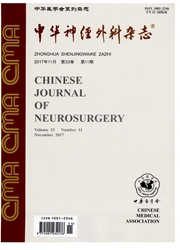

 中文摘要:
中文摘要:
目的评价卡莫司汀缓释植入剂治疗复发性恶性胶质瘤的安全性及初步疗效。方法回顾性分析2011年1月至2012年12月中山大学肿瘤防治中心神经外科及国内5所医院神经外科收治的22例复发性恶性胶质瘤的患者,在手术切除肿瘤后,瘤腔放置卡莫司汀缓释植入剂。详细记录患者术后28d内的不良反应,评价其安全性。记录患者放置缓释植入剂后的生存时间,初步评价药物的疗效。结果共22例患者接受局部缓释化疗。12例肿瘤全切除,8例次全切除,2例部分切除。其中植入3枚缓释剂的3例,植入6枚的3例,植入8枚的4例,植入9枚的3例,植入10枚的3例,植入12枚的6例。缓释剂植入28d后,11例患者未行其他治疗,8例行基于亚硝脲类化疗药物或替莫唑胺化疗,3例患者行放疗及化疗。缓释植入剂最常见的不良反应为头皮下积液(9例),其他不良反应包括皮疹(2例)、血小板减少(1例)及红细胞减少(1例)。平均随访时间为55个月,22例患者中,死亡20例,2例至末次随访仍存活。22例患者的中位生存期为322d(95%CI173~471)。结论卡莫司汀缓释植入剂耐受性好,使用安全,有延长复发性恶性胶质瘤患者生存期的趋势,值得开展Ⅲ期临床试验,以评价其疗效。
 英文摘要:
英文摘要:
Objective To evaluate the safety and primary efficacy of BCNU-loaded biodegradable implants for the treatment of recurrent malignant gliomas. Methods From January 2011 to December 2012, 22 patients with recurrent malignant glioma treated at the Department of Neurosurgery, Sun Yat-sen University Cancer Center and the Department of Neurosurgeries of 5 hospitals in China were analyzed retrospectively. The BCNU-loaded implants were placed into the tumor cavities after surgical resection of gliomas. The adverse reactions of the patients within 28 d after procedure were documented in detail. Its safety was evaluated. The survival time and the efficacy of preliminary drug evaluation after placing the implants in patients were recorded. Results A total of 22 patients received local sustained release chemotherapy. The gliomas of 12 patients were totally reseeted, 8 were subtotally reseeted, and 2 were partially reseeted. Three BCNU-loaded biodegradable implants were implanted in 3 cases, 6 were implanted in 3 cases, 8 were implanted in 4 cases, 9 were implanted in 3 cases, 10 were implanted in 3 cases, and 12 were implanted in 6 cases. At day 28 after implantation, 11 patients did not have other treatment, 8 received the chemotherapeutic drugs based on nitrosoureas or temozolomide chemotherapy, and 3 received both radiotherapy and chemotherapy. The most common adverse reaction of the implants was subgaleal effusion ( n = 9). Other adverse reactions included rash ( n = 2) , thrombocytopenia ( n = 1 ) , and erythrocytopenia ( n = 1 ). The mean follow-up time was 55 months. Twenty of 22 patients died and 2 were still alive up to the last follow-up. The median survival time of the 22 patients was 322 d (95% CI 173-471 d). Conclusions The BCNU-loaded biodegradable implants are well tolerated and safe. The agents have a tendency of prolonging the survival time of patients with recurrent malignant glioma. It is worth conducting phase Ⅲ clinical trial to evaluate the efficacy.
 同期刊论文项目
同期刊论文项目
 同项目期刊论文
同项目期刊论文
 期刊信息
期刊信息
